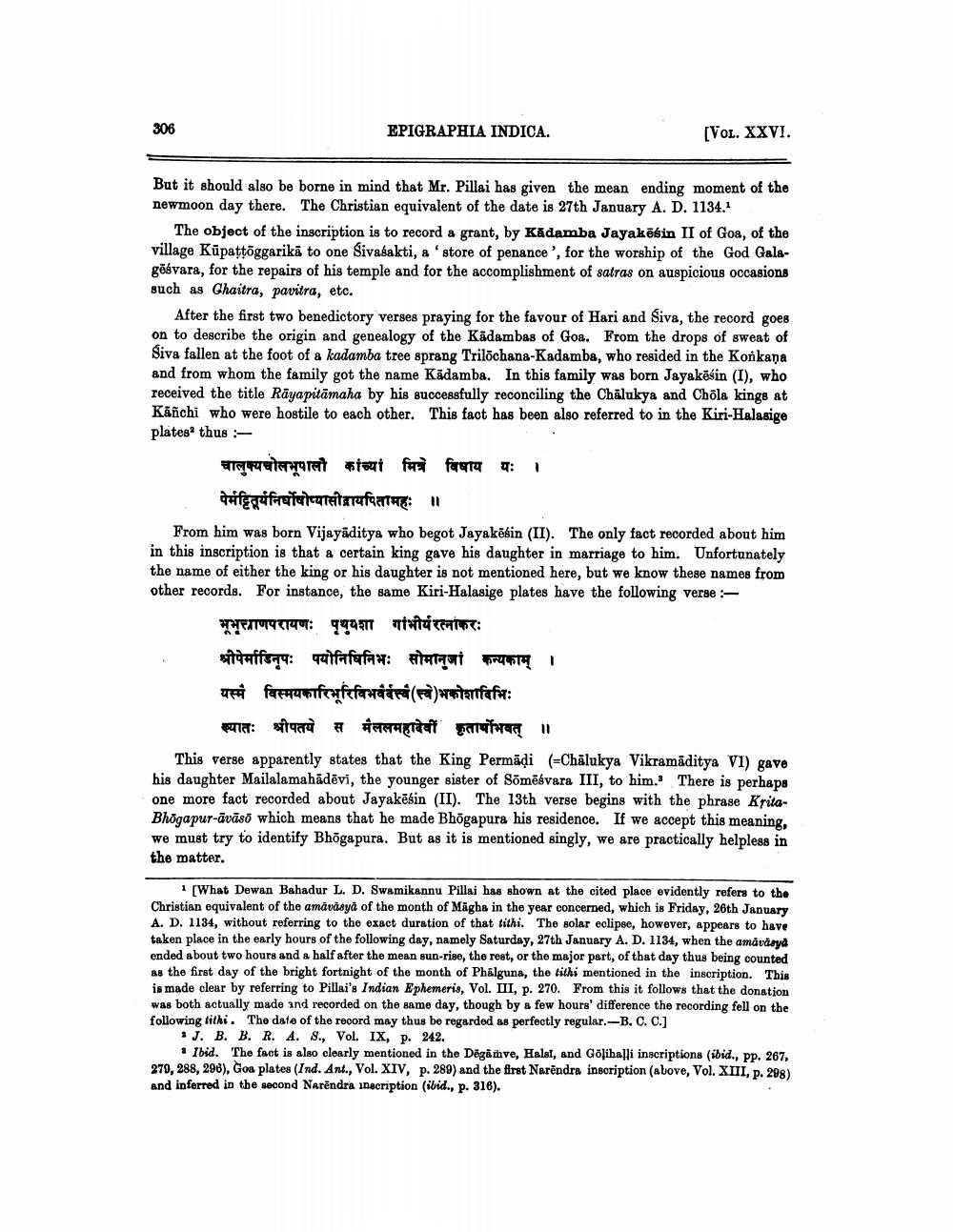________________
306
EPIGRAPHIA INDICA.
[VOL. XXVI.
But it should also be borne in mind that Mr. Pillai has given the mean ending moment of the newmoon day there. The Christian equivalent of the date is 27th January A. D. 1134.
The object of the inscription is to record a grant, by Kadamba Jayaköbin II of Goa, of the village Küpattöggarikā to one Sivasakti, a 'store of penance ', for the worship of the God Galagēsvara, for the repairs of his temple and for the accomplishment of satras on auspicious occasions such as Chaitra, pavitra, etc.
After the first two benedictory verses praying for the favour of Hari and Siva, the record goes on to describe the origin and genealogy of the Kādambas of Goa. From the drops of sweat of Siva fallen at the foot of a kadamba tree sprang Trilochana-Kadamba, who resided in the Konkana and from whom the family got the name Kādamba. In this family was born Jayakēsin (I), who received the title Räya pitämaha by his successfully reconciling the Chalukya and Chola kings at Kāñchi who were hostile to each other. This fact has been also referred to in the Kiri-Halasige plates thus
चालुक्यचोलभूपाली कांच्या मित्रे विषाय यः ।
पेमट्टितूर्यनिर्घोषोप्यासीद्रायपितामहः ॥ From him was born Vijayāditya who begot Jayakēsin (II). The only fact recorded about him in this inscription is that a certain king gave his daughter in marriage to him. Unfortunately the name of either the king or his daughter is not mentioned here, but we know these names from other records. For instance, the same Kiri-Halasige plates have the following verse -
भूभृत्वाणपरायणः पृथुयशा गांभीर्यरत्नाकरः श्रीपेर्माडिनृपः पयोनिषिनिभः सोमानुजां कन्यकाम् । यस्मै विस्मयकारिभूरिविभववत्त्व (स्वे)भकोशादिभिः
ख्यातः श्रीपतये स मैललमहादेवीं कृतार्थोभवत् ॥ This verse apparently states that the King Permādi (=Chalukya Vikramāditya VI) gave his daughter Mailalamahādēvi, the younger sister of Sõmēsvara III, to him. There is perhaps one more fact recorded about Jayakēsin (II). The 13th verse begins with the phrase KritaBhögapur-āvāso which means that he made Bhögapura his residence. If we accept this meaning, we must try to identify Bhögapura. But as it is mentioned singly, we are practically helpless in the matter.
1 (What Dewan Bahadur L. D. Swamikannu Pillai has shown at the cited place evidently refers to the Christian equivalent of the amavdays of the month of Māghs in the year concerned, which is Friday, 26th January A. D. 1134, without referring to the exact duration of that lithi. The solar eclipse, however, appears to have taken place in the early hours of the following day, namely Saturday, 27th January A. D. 1134, when the amavdaya ended about two hours and a half after the mean sun-rise, the rest, or the major part, of that day thus being counted as the first day of the bright fortnight of the month of Phálguna, the tithi mentioned in the inscription. This is made clear by referring to Pillai's Indian Ephemeris, Vol. III, p. 270. From this it follows that the donation was both actually made and recorded on the same day, though by a few hours' difference the recording fell on the following tithi. The date of the record may thus be regarded as perfectly regular.-B. C. C.]
. J. B. B. R. A. 8., Vol. IX, p. 242.
• Ibid. The fact is also clearly mentioned in the Degūmve, Halsl, and Göļihalli inscriptions (ibid., pp. 267, 279, 288, 298), Goa plates (Ind. Ant., Vol. XIV, p. 289) and the first Narendra inscription (above, Vol. XIII, p. 298) and inforred in the second Narendra inscription (ibid., p. 316).




